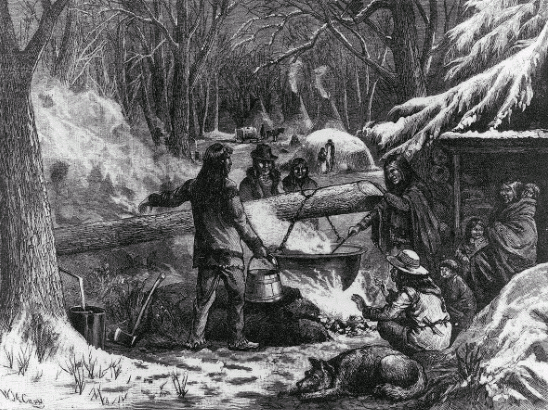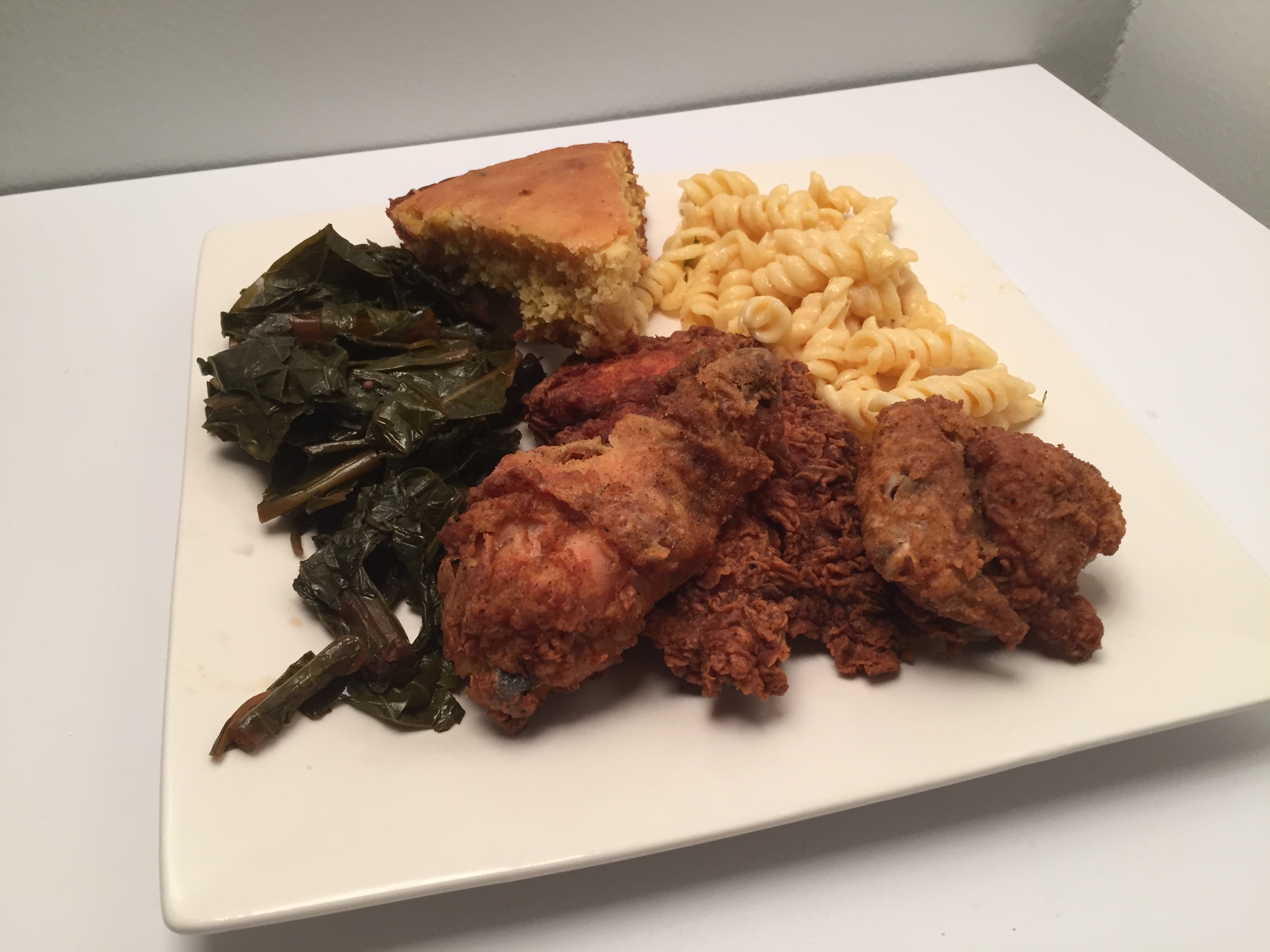|
Spoonbread
Spoonbread is a moist cornmeal-based dish prevalent in parts of the Southern United States. While the basic recipe involves the same core ingredients as cornbread – namely cornmeal, milk, butter, and eggs – the mode of preparation creates a final product with a soft, rather than crumbly, texture. As the name implies, the consistency is soft enough that it needs to be served and eaten with a spoon. Although named a "bread", spoonbread is closer in consistency and taste to many savory puddings, such as Yorkshire pudding. The basic recipe involves making a cornmeal mush from cornmeal and milk or water, which is then set aside to cool slightly. After that melted butter, beaten eggs, and any seasonings are stirred in, and the batter is poured into a buttered cast-iron skillet or baking dish and baked until set. There are two basic variations, depending on how the eggs are treated: if the eggs are beaten whole, it creates a denser version with a pudding-like texture; if the eggs ... [...More Info...] [...Related Items...] OR: [Wikipedia] [Google] [Baidu] |
Berea, Kentucky
Berea ( ) is a List of cities in Kentucky, home rule-class city in Madison County, Kentucky, Madison County, Kentucky, in the United States. The town is best known for its art festivals, historic restaurants and buildings, and as the home to Berea College, a private liberal arts college. The population was 15,539 at the United States Census, 2020, 2020 census. It is one of the fastest-growing towns in Kentucky, having increased by 27.4% since 2000. Berea is a principal city of the Richmond, Kentucky, Richmond−Berea Richmond-Berea micropolitan area, Micropolitan Statistical Area, which includes Madison and Rockcastle County, Kentucky, Rockcastle counties. It was formally incorporated by the Kentucky Assembly, state assembly in 1890.Commonwealth of Kentucky. Office of the Secretary of State. Land Office. "Berea, Kentucky". Accessed 15 July 2013. History The history of Berea is tied with the history of Berea College, which was founded in 1855. The Berea railway station was creat ... [...More Info...] [...Related Items...] OR: [Wikipedia] [Google] [Baidu] |
Cornmeal
Maize meal is a meal (coarse flour) ground from dried maize. It is a common staple food and is ground to coarse, medium, and fine consistencies, but it is not as fine as wheat flour can be.Herbst, Sharon, ''Food Lover's Companion'', Third Edition, Pg. 165, Barrons Educational Series Inc, 2001 In Mexico and Louisiana, very finely ground cornmeal is referred to as corn flour. When fine cornmeal is made from maize that has been soaked in an alkaline solution, e.g., limewater (a process known as nixtamalization), it is called masa harina (or masa flour), which is used for making arepas, tamales, and tortillas. Boiled cornmeal is called polenta in Italy and is also a traditional dish and bread substitute in Romania. Types There are various types of cornmeal: *''Blue cornmeal'' is light blue or violet in color. It is ground from whole blue corn and has a sweet flavor. The cornmeal consists of dried corn kernels that have been ground into a fine or medium texture. *''Steel-gro ... [...More Info...] [...Related Items...] OR: [Wikipedia] [Google] [Baidu] |
Indigenous Cuisine Of The Americas
Indigenous cuisine of the Americas includes all cuisines and food practices of the Indigenous peoples of the Americas. Contemporary Native peoples retain a varied culture of traditional foods, along with the addition of some post-contact foods that have become customary and even iconic of present-day Indigenous American social gatherings (for example, frybread). Foods like cornbread, Turkey meat, turkey, cranberry, blueberry, hominy, and Mush (cornmeal), mush have been adopted into the cuisine of the broader United States population from Native American cultures. In other cases, documents from the early periods of Indigenous American contact with European, African, and Asian peoples have allowed the recovery and revitalization of Indigenous food practices that had formerly passed out of popularity. The most important Indigenous American crops have generally included Indian corn (or maize, from the Taíno name for the plant), beans, squash, pumpkins, sunflowers, wild rice, sweet ... [...More Info...] [...Related Items...] OR: [Wikipedia] [Google] [Baidu] |
The Food Timeline
Lynne Olver (1958–2015) was a librarian and food historian, and the sole author of the ''Food Timeline'' website. Personal life Olver graduated from the University of Albany (SUNY). She was a librarian at the Morris County Library, New Jersey, and became its director in 2009. ''The Food Timeline'' In 1999, Olver created ''The Food Timeline'', a history website documenting culinary history, food history and recipes. Unlike many other food related websites, Olver gave citations to almost every statement on her site so that readers can verify her claims. Her research has been cited in peer-reviewed journals. In 2020, it was reported that the Olver family was searching for a person or persons to maintain and possibly grow the website. Virginia Tech On November 11, 2020, the Olver family announced on the ''Food Timeline'''s Twitter account that they selected the Virginia Tech The Virginia Polytechnic Institute and State University, commonly referred to as Virginia T ... [...More Info...] [...Related Items...] OR: [Wikipedia] [Google] [Baidu] |
Baking Powder
Baking powder is a dry chemical leavening agent, a mixture of a carbonate or bicarbonate and a weak acid. The base and acid are prevented from reacting prematurely by the inclusion of a buffer such as cornstarch. Baking powder is used to increase the volume and lighten the texture of baked goods. It works by releasing carbon dioxide gas into a batter or dough through an acid–base reaction, causing bubbles in the wet mixture to expand and thus leavening the mixture. The first ''single-acting'' baking powder (meaning that it releases all of its carbon dioxide as soon as it is dampened) was developed by food manufacturer Alfred Bird in England in 1843. The first ''double-acting'' baking powder, which releases some carbon dioxide when dampened and later releases more of the gas when heated by baking, was developed by Eben Norton Horsford in the U.S. in the 1860s. Baking powder is used instead of yeast for end-products where fermentation flavors would be undesirable, or wher ... [...More Info...] [...Related Items...] OR: [Wikipedia] [Google] [Baidu] |
Baking Soda
Sodium bicarbonate (IUPAC name: sodium hydrogencarbonate), commonly known as baking soda or bicarbonate of soda (or simply “bicarb” especially in the UK) is a chemical compound with the formula NaHCO3. It is a salt (chemistry), salt composed of a sodium cation (Sodium, Na+) and a bicarbonate anion (). Sodium bicarbonate is a white solid that is crystalline but often appears as a fine powder. It has a slightly salty, alkaline taste resembling that of washing soda (sodium carbonate). The natural mineral form is nahcolite, although it is more commonly found as a component of the mineral trona. As it has long been known and widely used, the salt has many different names such as baking soda, bread soda, cooking soda, brewing soda and bicarbonate of soda and can often be found near baking powder in stores. The term ''baking soda'' is more common in the United States, while ''bicarbonate of soda'' is more common in Australia, the United Kingdom, and New Zealand. Abbreviated colloqu ... [...More Info...] [...Related Items...] OR: [Wikipedia] [Google] [Baidu] |
Soul Food
Soul food is the ethnic cuisine of African Americans. Originating in the Southern United States, American South from the cuisines of Slavery in the United States, enslaved Africans transported from Africa through the Atlantic slave trade, soul food is closely associated with the cuisine of the Southern United States. The expression "soul food" originated in the mid-1960s when "soul" was a common word used to describe African-American culture. Soul food uses cooking techniques and ingredients from West African cuisine, West African, Cuisine of the Central African Republic, Central African, European cuisine, Western European, and Indigenous cuisine of the Americas. The cuisine was initially denigrated as low quality and belittled because of its origin. It was seen as low-class food, and African Americans in the Northern United States, North looked down on their Black Southerners, Black Southern compatriots who preferred soul food (see the Great Migration (African American), Grea ... [...More Info...] [...Related Items...] OR: [Wikipedia] [Google] [Baidu] |
James Hemings
James Hemings (c. 17651801) was the first American to train as a chef in France. Three-quarters white in ancestry, he was born into slavery in Virginia in 1765. At eight years old, he was purchased by Thomas Jefferson at his residence of Monticello. He was an older brother of Sally Hemings and a half-sibling of Jefferson's wife Martha Jefferson. Martha, Sally, and James shared John Wayles as a father. It was said that Wayles had taken James's mother Betty Hemings, who was his helper, as his concubine. As a young man, Hemings was selected by Jefferson to accompany him to Paris when the latter was appointed Minister to France. There, Hemings was trained to be a French chef; independently, he took lessons to learn how to speak French. Hemings is credited with bringing many French cooking styles to the colonial United States and developing new recipes inspired by French cuisine. This includes crème brûlée and meringues, but most famously, Hemings is credited with introducing ma ... [...More Info...] [...Related Items...] OR: [Wikipedia] [Google] [Baidu] |
French Cuisine
French cuisine is the cooking traditions and practices of France. In the 14th century, Guillaume Tirel, a Court (royal), court chef known as "Taillevent", wrote ''Le Viandier'', one of the earliest recipe collections of medieval France. In the 17th and 18th centuries, chefs François Pierre La Varenne and Marie-Antoine Carême spearheaded movements that shifted French cooking away from its foreign influences and developed France's own indigenous style. French cheese, Cheese and French wine, wine are a major part of the cuisine. They play different roles regionally and nationally, with many variations and ''appellation d'origine contrôlée'' (AOC) (regulated appellation) laws. Culinary tourism and the ''Guide Michelin'' helped to acquaint commoners with the ''cuisine bourgeoise'' of the urban elites and the peasant cuisine of the French countryside starting in the 20th century. Many dishes that were once regional have proliferated in variations across the country. Knowledg ... [...More Info...] [...Related Items...] OR: [Wikipedia] [Google] [Baidu] |
Nantucket Island
Nantucket () is an island in the state of Massachusetts in the United States, about south of the Cape Cod peninsula. Together with the small islands of Tuckernuck and Muskeget, it constitutes the Town and County of Nantucket, a combined county/town government. Nantucket is the southeasternmost town in both Massachusetts and the New England region. The name "Nantucket" is adapted from similar Algonquian names for the island. Nantucket is a tourist destination and summer colony. Due to tourists and seasonal residents, the population of the island increases to around 80,000 during the summer months. The average sale price for a single-family home was $2.3 million in the first quarter of 2018. The National Park Service cites Nantucket, designated a National Historic Landmark District in 1966, as being the "finest surviving architectural and environmental example of a late 18th- and early 19th-century New England seaport town." History Etymology Nantucket probably takes ... [...More Info...] [...Related Items...] OR: [Wikipedia] [Google] [Baidu] |
Hominy Grits
Grits (stylized as GRITS) is an American Christian hip hop group from Nashville, Tennessee. Their name is an acronym, which stands for "Grammatical Revolution In the Spirit". GRITS is made up of Stacey "Coffee" Jones and Teron "Bonafide" Carter, both of whom were DC Talk dancers. Their song " Ooh Ahh" has appeared on the MTV show ''My Super Sweet 16''. It is also used as the theme song of '' The Buried Life'' and on the soundtracks to '' The Fast and the Furious: Tokyo Drift'' and '' Big Momma's House 2''. Their song "Tennessee Bwoys" was used on the popular television show ''Pimp My Ride''. They were also involved in ''!Hero The Rock Opera''. They recorded a remix of professional wrestler A.J. Styles' entrance music and performed it on the May 28, 2009, episode of ''TNA Impact!''. Background The Christian hip hop duo began as dancers for DC Talk and then formed the group in 1995, with Teron David "Bonafide" Carter, (born January 17, 1971) and Stacy Bernhard "Coffee" Jones, ( ... [...More Info...] [...Related Items...] OR: [Wikipedia] [Google] [Baidu] |






